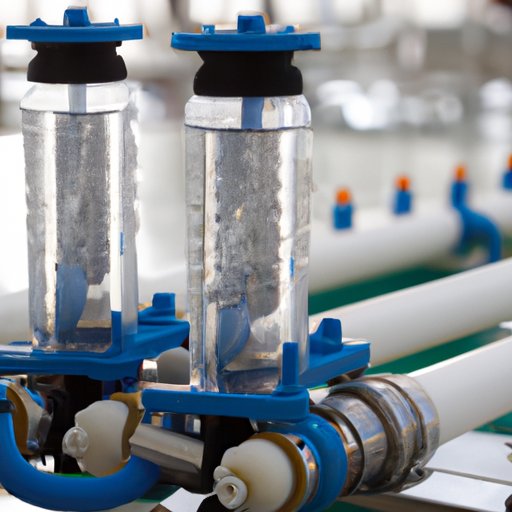Introduction
Desalination is the process of removing salt and other minerals from saline water, such as seawater or brackish groundwater, to make it suitable for human consumption and other uses. Although this process has been around for centuries, it has become increasingly important in recent years due to global population growth, climate change, and increasing water scarcity. In this article, we will take an in-depth look at how desalination works and explore the different types of desalination processes and technologies.
Exploring the Basics of Desalination: How Does It Work?
Desalination is a process that removes salts and other minerals from saline water, making it suitable for human consumption and other uses. It is a complex process that involves several steps, including pre-treatment, filtration, and post-treatment. The most common desalination methods are reverse osmosis, thermal desalination, and electrodialysis.
An In-Depth Look at the Process of Desalination
The process of desalination begins with pre-treatment, which involves removing suspended solids, organic matter, and other contaminants from the water. This is followed by filtration, which involves passing the water through membranes or filters to remove salts and other minerals. Finally, post-treatment is used to further purify the water and make it safe for human consumption and other uses.
There are three main types of desalination processes: reverse osmosis, thermal desalination, and electrodialysis. Each of these processes works differently, but all involve the same basic steps of pre-treatment, filtration, and post-treatment.
A Step-by-Step Guide to Understanding Desalination
Reverse osmosis (RO) is one of the most commonly used desalination processes. RO works by using pumps to pressurize saline water, forcing it through a semi-permeable membrane. The membrane allows water molecules to pass through while rejecting larger molecules, such as salt and other minerals. The filtered water is then collected on the other side of the membrane.
Thermal desalination uses heat to evaporate water, leaving behind salts and other minerals. The vaporized water is then condensed, collected, and stored for later use. This method is typically used in arid regions where there is an abundance of solar energy.
Electrodialysis (ED) is another desalination process that uses electric current to separate salts and other minerals from water. This process involves passing saline water between two electrodes, which creates an electrical field that separates the ions and molecules in the water. The filtered water is then collected on the other side of the electrodes.

Deconstructing the Science Behind Desalination
The chemistry of desalination involves the separation of ions and molecules from saline water. This is done by either creating a difference in pressure or by using electric current. Pressure differences can be created by using pumps in reverse osmosis systems or by boiling the water in thermal desalination systems. Electric current is used to separate ions and molecules in electrodialysis systems.
In addition to the chemistry of desalination, pressure considerations must also be taken into account. The pressure needed to force saline water through a semi-permeable membrane or to boil water varies depending on the type of desalination process being used. For example, reverse osmosis requires higher pressures than thermal desalination.
Unpacking the Mechanics of Desalination
Membranes are an essential part of desalination systems. These membranes are designed to allow only certain molecules to pass through while rejecting larger molecules, such as salt and other minerals. Membranes can be made out of a variety of materials, such as polyethylene, cellulose acetate, or polysulfone.
Pumps are also an important component of desalination systems. Pumps are used to create pressure differences in reverse osmosis systems and to circulate water in electrodialysis systems. Different types of pumps can be used depending on the application.
Conclusion
Desalination is a complex process that involves several steps, including pre-treatment, filtration, and post-treatment. There are three main types of desalination processes: reverse osmosis, thermal desalination, and electrodialysis. All of these processes involve the same basic steps of pre-treatment, filtration, and post-treatment. The chemistry of desalination involves the separation of ions and molecules from saline water, while pressure considerations must also be taken into account. Membranes and pumps are essential components of desalination systems.
Desalination is a crucial tool for providing clean, fresh water to communities around the world. It can help reduce water scarcity and improve access to clean water for people in areas where freshwater sources are limited. Desalination also has the potential to reduce our reliance on fossil fuels, as many desalination processes use renewable energy sources such as solar or wind power. As the demand for clean water continues to increase, desalination will play an increasingly important role in meeting that need.
(Note: Is this article not meeting your expectations? Do you have knowledge or insights to share? Unlock new opportunities and expand your reach by joining our authors team. Click Registration to join us and share your expertise with our readers.)
